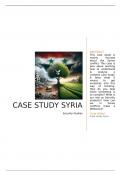ABSTRACT
This case study is
mainly focused
about the Syrian
conflict. This case is
also about learning
how to understand
& analyse a
complex case study.
It tests what it
means to get
ourselves into this
way of thinking.
How do you deal
when something is
so complex? What is
our role as Security
students? How can
CASE STUDY SYRIA we in
conflicts make a
difference?
future
Security Studies Yulia Göbel
Case study Syria
,CONCEPTS..................................................................................................................................................0
SUMMARY.................................................................................................................................................1
CONCEPTS..................................................................................................................................................6
SUMMARY.................................................................................................................................................7
CONCEPTS & TREATIES................................................................................................................................14
SUMMARY...............................................................................................................................................15
TIMELINE.............................................................................................................................................. 15
CONCEPTS................................................................................................................................................18
TIMELINE.................................................................................................................................................19
SUMMARY...............................................................................................................................................22
CONCEPTS................................................................................................................................................30
SUMMARY...............................................................................................................................................30
Introduction to Case study Syria 30-10-2023
Concepts
Arab Spring= a wave of protest movements spreading across Northen-
Africa
& the Middle East.
Foreign fighters= they often share that ‘war’ is brotherhood, bonding,
adventure etc.
Hezbollah= group in Lebanon supported by Iran.
Glocal= event that is global in reach or scale > impacts locally &
internationally.
Performative violence
Violence that doesn’t have a direct strategic purpose (doesn’t eliminate a
fighting group) but is does speak to a wider purpose of destroying an
identity (cultural ideas, in this case, encountered ISIS).
Proxy war= when powerful (non-)state actors receive financial, political,
military support from another country to further their political
, Case study Syria
interest.
Rules of engagement
Within a coalition, countries have different perceptions and their rules on
how to deal with a situation. The Netherlands, for instance, were only
going to participate in air attacks on ISIS in Iraq, and not in Syria. So, in
2015, they bombed a weapon factory, which had a greater explosion than
they expected, which killed many innocent civilians.
Sykes-Picot Agreement
Secret treaty about the division of the Middle East Ottoman countries
between the UK (Iraq) & France (Syria). They did so without any regard for
already existing cooperation between tribes or trading routes, creating
unrest. One of ISIS primary goals was to undo these agreements.
(Germany, US, Italy, and Russia were less involved).
Summary
Many starting point to choose from of the Syria conflict:
17th century: the start of the end for Ottoman Empire.
1916: decolonisation > secret Sykes-Picot Agreement.
o When you start studying the war is Syria & ISIS, many of the
grievances & narratives relate to this moment.
1963 of 1971-2000: Hafez AL-Assad > Syrian politician & president.
o Bashar Al-Assad was his 2nd son;
o His party started the Al-Assad dynasty and changed the way politics
worked in Syria;
Sectarianism, economic policy > changed the social fabric of the
country and set the stage for unrest to grow.
o Already a dictator, but still treated Syrians with compassion. He did
not use the military against them, seeing himself as neutral.
9-4-2003: Firdos square statue destruction > a group of Iraqi civilians
started to attack the statue of Saddam Hussein. Took place
after
the invasion of Iraq in 2003 by the USA, as the symbolic end
of
the Battle of Baghdad.
17 -09-2010: The Arab spring was catalysed by the self-immolation of a
th
25-years old Tunisian man, Mohammed Bouazizi.
o He set fire to himself;
o Protesting economic & political situation;
o Consequently, the government was overthrown and the start of the
Arab Spring > Syrian Civil War
10-03-2010: a schoolboy Naief Abazid (14) wrote 'It's your turn doctor'
on
their school wall.
o Al-Assad was an eye-doctor;
Was brough back from London to Syria when his brother, Bassel,
(car crash 1994) & father died to become the next leader of Syria.
o The boys were detained & tortured and consequently large-scale
protest in Daraa erupted;
o These protests fuelled for democratic reforms, and ever after this
event, protests shaped.
Page 1 of 41
, Case study Syria
17 December 2010: Bashar Al-Assad.
15 March 2011: 'Day of Rage' > hundreds of protests in Damascus and
Aleppo took place, calling for democratic reforms.
'De-ba'athification'. In both Syria and Iraq, the Ba'ath party was in charge,
in Syria led by the Assad family. When the VS took over Iraq, they fired
everybody connected to the Ba'ath party, causing a big group of intelligent
and educated angry people.
What are we trying to study > human suffering (humanitarian crisis).
o 30 million internal & external displaced Syrians;
o 7 million people have fled the country (neighbouring countries, EU,
etc.
Who are involved?
Complex picture of understanding which groups all play a role?
Local nationsl factions;
International factions;
o Supported by EU, US, Russia, Iran etc.
o More or less groups or smaller countries that are supported by an
international superpower.
Bring in greater geopolitical interests into this small land?
From Civil War to involvement Jihadism (ISIS).
o World started to become familiar with this group.
2012: American journalist, James Foley, captured and a video in
2014
got released of his beheading and multiple others’
beheading.
o Released a whole new dynamic in conflict, the international
involvement changed, public opinion started to interpret in a
different way.
June 2014: Abu Bakr al-Baghdadi establishing a caliphate > ISIS
transformed from a terrorist organization to a state.
o Had all kinds of effects locally & internationally.
Limburgse Sultan Berzel (19) became a suicide terrorist of Jihadist
ISIS-group (Iraq) and blew himself up, killing over 20 people.
Studying EU & US impact.
o 13-11-2015: Paris & Saint-Denis, France terrorist attacks.
o Belgium, Germany & UK.
These terror attacks became a huge trigger turning point for
many countries to get involved more into this (Iraq-Syrian)
conflict.
Wasn’t about fighting (human) rights & democracy anymore but
fighting against terrorism, Jihadists groups.
The roles of the countries started to change.
Migration ‘crisis’
A million of Syrians had reached Europe, which changed European
politics.
Page 2 of 41






